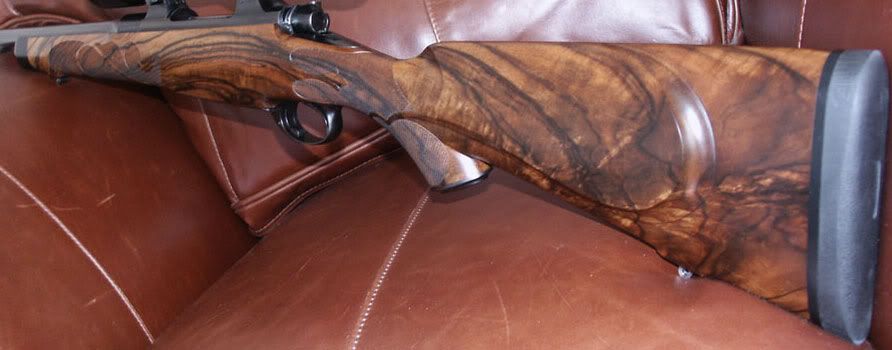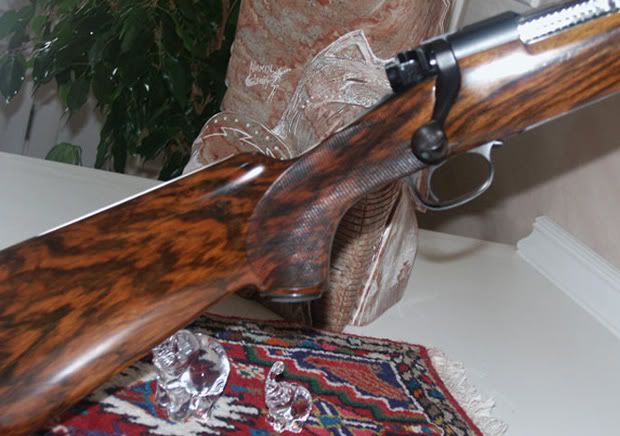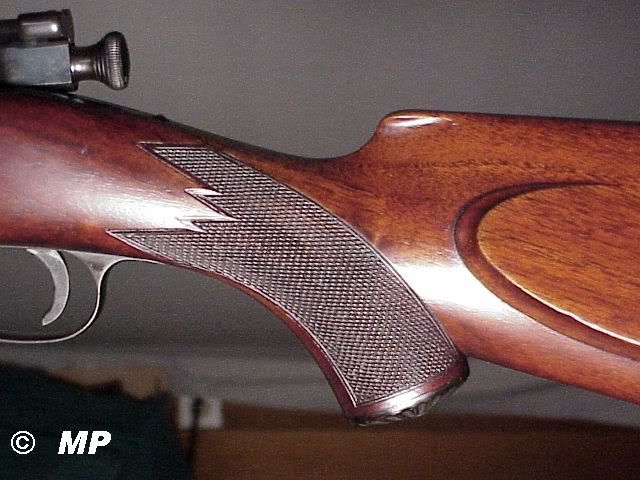

 The Accurate Reloading Forums
The Accurate Reloading Forums  THE ACCURATE RELOADING.COM FORUMS
THE ACCURATE RELOADING.COM FORUMS  Guns, Politics, Gunsmithing & Reloading
Guns, Politics, Gunsmithing & Reloading  Gunsmithing
Gunsmithing  Linseed and Tung oil finishes
Linseed and Tung oil finishesGo  | New  | Find  | Notify  | Tools  | Reply  |  |
one of us |
Does anyone have pictures of stocks with a linseed or tung oil finish. I will be finishing a claro walnut stock soon and wanted to see some options. --------------------------------- It's better to have it and not need it than to need it and not have it | ||
|
| One of Us |
I don't have any pics, just wanted to comment. Most people don't use linseed oil as a surface finish. It never completely hardens to the same hardness as tung oil and it will eventually flow out of the wood (very slowly, but it does happen). Used together they look great. Most people who use linseed oil (make sure its boiled linseed oil) first soak it into the wood until it won't take up any more. They put a heavy coat on, come back an hour later and reapply more, and keep doing it until it just won't absorb any more. After that they let it cure for a few days, then rub it with some steel wool and finish it with tung oil. The linseed oil really brings out the grain and color. | |||
|
| one of us |
I am finishing a really pretty Claro buttstock in Tung Oil. I will post pictures when it is done, as I should finish it by the end of the week. -Spencer | |||
|
| one of us |
The tung oil finishes you will find today will have synthetic resins, urathane resins etc in them and they dry pretty fast. Ive used about 4 different brands of tungoil and usualy it says Danish oil finish on the can. You can mix up your own brew too . Ive mixed boiled linseed oil in with danish oil . I thought about mixing some linseed with some spar to see what happens. | |||
|
| One of Us |
The following stock was done with a polymer modified Tung oil. Straight tung oil also has it's draw backs and most in regard to drying. Linseed oil is not a good finish and is not very resistant to water.  | |||
|
| One of Us |
Here are two stocks that were treated with tung oil. These are Myrtle wood stocked FN Whbys. They started out being very light.  Rusty We Band of Brothers! DRSS, NRA & SCI Life Member "I am rejoiced at my fate. Do not be uneasy about me, for I am with my friends." ----- David Crockett in his last letter (to his children), January 9th, 1836 "I will never forsake Texas and her cause. I am her son." ----- Jose Antonio Navarro, from Mexican Prison in 1841 "for I have sworn upon the altar of god eternal hostility against every form of tyranny over the mind of man." Thomas Jefferson Declaration of Arbroath April 6, 1320-“. . .It is not for glory, nor riches, nor honours that we are fighting, but for freedom - for that alone, which no honest man gives up but with life itself.” | |||
|
| One of Us |
Linseed oil shouldn't be a surface finish at all on a rifle stock. It should only be used for enhancing the wood's grain and color under a different surface finish. You should try out boiled linseed oil with a few top coats of Waterlocs. It is a poly based finish that is more durable than most polys and regular tung oils and looks (IMHO) better than tung oil. | |||
|
one of us |
Customstox, very nice as usual. Is that pad Barney leather ? ______________________ Always remember you're unique, just like everyone else. | |||
|
| one of us |
Oil finishes unbeatable,   Roland | |||
|
| one of us |
Beautifully done Roland!!! | |||
|
| one of us |
Roland is that a G.A.G. stock? nice finish | |||
|
| One of Us |
Linseed will make your stock too dark. Especially with open grained wood. I used linseed on a nice piece of english. Came out as very dark with black streaks. I have no use for linseed as a finish these days. | |||
|
one of us |
Here's a pawnshop Mauser stock I'm in the middle of refinishing with Formby's tung oil. It is still soaking up alot of oil and the pores aren't filled yet. I'll retrace the original checkering lines which aren't too bad if I ever get the finish looking right. The wood was very light after I finished sanding, has darkened considerably with each subsequent coat of oil.  NRA Life Member, Band of Bubbas Charter Member, PGCA, DRSS. Shoot & hunt with vintage classics. | |||
|
one of us |
So if my stock is dark already, avoid linseed? If it's not too dark and I want to bring out the grain, use linseed. Otherwise finnish with tungoil or some version of it? Sorry if I'm not in the know here, but all these finnishes are not my specialty. --------------------------------- It's better to have it and not need it than to need it and not have it | |||
|
| one of us |
I always use some kind of modified tung oil...For a hunting rifle that is going to see a lot of hard use I still like Varithane in the yellow can on top of a good filler...It takes forever to finish a stock with it, but it will take hard weather better than all the other stuff I have tested...I did a lot of pieces of wood and stuck them on the shop roof for a couple of years...Varathane won...but it has something in it that is supposedly cancer causing so I guess you should wear gloves when working with it... Lots of polymer modified oil finishes out there and they are all pretty good... Ray Atkinson Atkinson Hunting Adventures 10 Ward Lane, Filer, Idaho, 83328 208-731-4120 rayatkinsonhunting@gmail.com | |||
|
| new member |
Of all the types of finishes discussed, which ones would be the most easy to touch up and repair after sanding out the usual scratches one gets it the field? | |||
|
one of us |
I'd say TrueOil. NRA Life Member, Band of Bubbas Charter Member, PGCA, DRSS. Shoot & hunt with vintage classics. | |||
|
| one of us |
Actually, Alvin Linden said the same thing over 60 years ago. A finish with strictly Linseed or Tung oil is inferior. I'm kind of surprised this issue keeps surfacing. There are finishes for gunstocks available with instructions for their use. There is also a plethora of information from smiths that use commercially available finishes in either Linseed and Tung oils modified with varnishes and/or urathanes. There's a smith on this forum that has a nice write-up on the Internet for "melting" Agraglas (or other epoxy) into the wood in two ro three sessions prior to finishing. A practice I use and swear by. It really toughens up the stock surface and makes checkering easier. I probably am a big advocate of it because my self-imposed budget relegates me to using a lot of piss-elm wood rather than nice "greasy" English Walnut.
Yep. And the products and instructions for use are readily available. I haven't read much recently that doesn't follow the same basic steps...... Dilute and soak some oil/solids/drying mixture until the wood won't take any more. Allow ample time to dry and set up. Fill pores by wet sanding with same mixture......or applications of some other material until level with surface. Allow ample time to dry and set up. Dress surface with thin applications of finish. Everybody has their favorites, and that extends to how dark or light......and how shiney or subdued the final finish is desired. But rest assured the magic ain't Linseed or Tung oil exclusively. And it probably ain't a speedy process. Spray painting plastic stocks is speedy. And you have complete flexibility of color and pattern. GV | |||
|
| <allen day> |
Why'd you throw the "Echols approved" part in? What's your point? AD | ||
|
| one of us |
That idea of smearing on Acraglas and then sanding it off actually sounds really interesting. I guess you would not want it to completely cover the entire stock like a shell but have it in the pores so you have like half wood and half Acraglas exposed. Did the finish look good when complete? I would also assume the Acraglass was not dyed? -Spencer | |||
|
| one of us |
Actually, the glass is heated into the wood rather than allowed to set up and be sanded. I've never allowed it to set up on top as Mark indicates it's a rather nasty mess if that happens. Finishing Gun Stocks With Acraglas Give it a try, Spencer. I think you'll be pleased. I actually am using a different product than Acraglas......although I use the same technique. I'm using "Power Poxy for Pros" from Menards. 8 oz of resin and 8 oz of hardener for $12. It's very runny (which is what you want in this application), slow setting (another advantage), clear, works deep into the wood under a hot hair dryer, and sets up hard within the wood. GV | |||
|
| one of us |
Too bad you mentioned this now, as I am right in the middle of finishing the aformentioned Claro buttstock. I don't understand why he says Acraglas is so hard to sand. In my experience, it sands rather well. -Spencer | |||
|
| one of us |
I wrote that article for gunshop.com back in the late '90's due to me answering a million emails on the process. I got th ebasis for the method form Gunsmith Kinks I believe. I've refined the process since then and it is now easier to do, but it takes a little longer (less handling time, but longer calandar time). The more I use that method, the better I like it. I still try different finishes occasionally, but I keep going back to "ole reliable". I am in the rpocess of writing some magazine articles, and this finishing method will get re-written in the next few months. I have just recovered from major surgery an dillness and I am in the process of starting a busienss, so writing ahs taken a back seat for a while. As for looks, you can make it look like anything from a "dull London finish" to the Remington "RKW" finish. Just depends on how you top it off. I always finish with oil because I like that look. Looks no different than a stock finished with straight oil. PS-I don't know who "Grandview" is, but him calling me a "smith" is overly generous. He is being very nice, as "hack" is much more fitting! | |||
|
| one of us |
Heh Heh.... "GrandView" is just another rank amateur, Marc. I read your article a few years ago and it made sense. One of the very few things I've read that put into practice greatly exceeded my expectations. I experienced all the pluses you mentioned....and more. Please keep us informed of upcoming articles on your further enhancements to the process. GV | |||
|
| one of us |
If your going to use the Accuglass as a filler or finish then you had better dilute it to the consistency of water and when the pores are filled, wet sand back to the wood, repeat as necessary..then finish with whatever finish that works with accuglass otherwise its just a mess and is worhtless...... Its just more trouble than its worth...better to use a good wood filler with a good polymer modified oil finish or poly Urathane plastic finish... As to a straight Linseed Oil finish, I have seen some beatiful stocks done in Linseed, and they worked just fine as far as I could tell, but they had a lot of coats of oil... Furthermore, I am not sure that the tales of woe on Linseed are altogeter true, and I beleive that they are based on handed down written matter as opposed to actual use and experience...I have had a couple of old guns and have one now with a 50 year or older Linseed finish on it and its never given me a problem.... I don't use it to finish guns today based on all the hype, guess I'm a victim of the reports also, but I am not convienced the bad reports are fact, based on actual use in the field... Some of the old guns from Holland and Holland, Rigby, Westley Richards are supposedly finished in Linseed and Alkanet, and they seemed to have held up as most are 100 plus years old... At least its an argueable point... Ray Atkinson Atkinson Hunting Adventures 10 Ward Lane, Filer, Idaho, 83328 208-731-4120 rayatkinsonhunting@gmail.com | |||
|
| one of us |
Rubbish!!! What do you think wetsanding is for?? The mud you create while wetsanding is used to fill the pores. Wood filler is fine for patching holes while doing general carpentry but has no place anywhere near a fine piece of walnut. | |||
|
| One of Us |
Here is what linseed oil finish looks like that was applied in 1916.  | |||
|
| One of Us |
Isn't a wooden stock, to a certain extent, a living breating thing that expands and contracts with temperature as well as with changes in humidity. Old plastic, hard finishes should get brittle and crack, ect after many years. Old oil finishes seem to exude a certain amount of class, even with hard use. Old hard finishes that have had hard use don't look so good (AKA cheap) on the used gun rack, in my opinion. Old chipped synthetic stocks just look bad. I prefer the feel of an oil based finish also. Paul Paul | |||
|
| One of Us |
At this point I'd Have just one thing to say. . .45/70! Seriously, as a guy who has no stock finishing experience, I appreciate those of you with all this knowledge. In all my years I have never had a stock finish go bad. I've never felt the need to "refinish a stock. Now granted I don't hunt in wet climates, but if you do, aren't there better options than finished wood? | |||
|
| one of us |
Bill S., Rubbish, You misread my post or I was unclear...I use a thin filler such as Truoil filler cut 50-50 or say thinned glass or whatever and soak the stock in it until it will not take anymore and let it sit up for for a week or two, then wet sand it and using a slick napkin or something that won't soak up the finnish and spread it across grain, wait about 20 minutes and light wipe off the excess, let dry repeat until pores are filled, then do the same with finish..This is basically what I ment, without going into detail...I didn't say anything about wood putty fillers? Ray Atkinson Atkinson Hunting Adventures 10 Ward Lane, Filer, Idaho, 83328 208-731-4120 rayatkinsonhunting@gmail.com | |||
|
| One of Us |
Hello, For those not caring for linseed oil(boiled) perhaps it is in the way it is applied. Old method of wet sanding was simple to do and actually quite quick and so far I have found durable and easy to repair. No magic forumlas, just a simple process. Tear or cut several 12-15 two inch squarers of 400 grit wet/dry paper, apply with fingers generous amount of oil, area about the size of your hand, proceed to sand WITH THE GRAIN that area until paper loads up, you will notice the black residue on the paper. Take paper towel, wipe off ACROSS THE GRAIN. Slightly overlap on the next area and continue till you have completed stock. Wipe entire stock with paper towels and apply light coat of oil and let stand overnight in warm area. Repeat above the second time or until the finish is smooth and the grain is filled. It will not take that long to fill the grain. Once that is done, repeat with 600 grit and by now the wood will have a very nice warm glow to it and actually quite durable. Aside from great finish, sense of accomplishment with the most basic of tools. Just a suggestion. Favor Center!! dsiteman | |||
|
One of Us |
Beautiful wood, BUTT-UGLY recoil pad!! "Bitte, trinks du nicht das Wasser. Dahin haben die Kuhen gesheissen." | |||
|
One of Us |
And it still looks good, and pretty new, too! "Bitte, trinks du nicht das Wasser. Dahin haben die Kuhen gesheissen." | |||
|
| one of us |
Deguello, A leather covered recoil pad is butt ugly, you gotta be kidding me, and thats an excellent job on the installation...I cannot think of a better and more practical touch..and it never hangs up on the shoulder when mounted or dismounted...Its about the finest touch one can add to a full blown custom rifle IMO..... Ray Atkinson Atkinson Hunting Adventures 10 Ward Lane, Filer, Idaho, 83328 208-731-4120 rayatkinsonhunting@gmail.com | |||
|
one of us |
I don't find the leather covered pads pleasing to the eye either. They just don't transition smoothly to the wood. Looks like a gap a house cat could get lost in....I'm not knocking the craftmanship, so please don't anyone take it that way. Sorta like game scene carving on rifles, some of it shows a great degree of skill, but just not my thing. ______________________ Always remember you're unique, just like everyone else. | |||
|
| one of us |
I don't know what dye or combinations of dyes were used, but that is a really nice pad, I like leather covered pads and that is top drawer. Billy, High in the shoulder (we band of bubbas) | |||
|
| one of us |
Billy, I think thats Burgundy. Chic can correct me if Im wrong but we have discussed that color before. I could do your 404 pad in that color if you like. | |||
|
| One of Us |
dempsey, I think they have to grow on you, but then warts do that too and they don't look so hot. That actually isn't a gap, it is a shadow. You have to trim the pad down about 1/2 to 2/3 the thickness of the leather. If you do it so the sides are flush and the trim is the thickness of the leather, you end up with the leather tucking under and a slight unguared edge of wood just at the juncture, so I leave them just a touch wider so the leather touches just as it finishes the radius under the pad and the wood in contact with the leather. Billy, it is burgundy as Bill said. I often mix just a touch of black in to darken and then also after it is done I accent the edges with some just a shade darker. Gives it an older look. Like jeans with holes "worn" in the knees used to sell for more money, but not to me. | |||
|
| One of Us |
Several months ago, I read post by someone on the exact process they use to finish a Stock in oil, form start to finish. Does anyone know who it was, or maybe you have your own version of the process you wouldnt mind posting here? I have a Wood stocked Ruger I would like to put Oil on this Spring, and really want to do a good job on it, but have never done so before.........can anyone help? Rod -------------------------------- "A hunter should not choose the cal, cartridge, and bullet that will kill an animal when everything is right; rather, he should choose ones that will kill the most efficiently when everything goes wrong" Bob Hagel | |||
|
| Powered by Social Strata | Page 1 2 |
| Please Wait. Your request is being processed... |
|
 The Accurate Reloading Forums
The Accurate Reloading Forums  THE ACCURATE RELOADING.COM FORUMS
THE ACCURATE RELOADING.COM FORUMS  Guns, Politics, Gunsmithing & Reloading
Guns, Politics, Gunsmithing & Reloading  Gunsmithing
Gunsmithing  Linseed and Tung oil finishes
Linseed and Tung oil finishes

Visit our on-line store for AR Memorabilia

